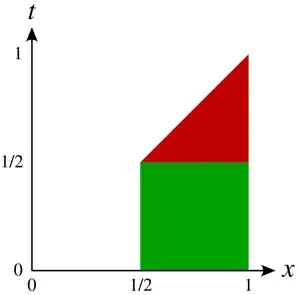We start with, $\displaystyle \int_{\frac{1}{2}}^1 F(x)\,dx = \int_{\frac12}^1\int_0^x f(t)\,dt \,dx = \frac{1}{2}\int_0^{\frac12} f(x)\,dx + \int_{\frac12}^1 (1-x)f(x)\,dx$
Thus we have, $$\displaystyle \int_0^1 x^2f(x)\,dx = -\int_0^{\frac12}f(x)\,dx - 2\int_{\frac12}^1 (1-x)f(x)\,dx$$
and, $$\displaystyle \int_0^1 f(x)\,dx = -\int_{\frac12}^1 (x-1)^2f(x)\,dx - \int_0^{\frac12} x^2f(x)\,dx$$
Hence, $\displaystyle \int_{\frac12}^1 \{1+(x-1)^2\}f(x)\,dx + \int_0^{\frac12} \{1+x^2\}f(x)\,dx = 0$
Say, $\phi(x) = 1+x^2 \textrm{ for } x \in [0,\frac12) \textrm{ and } 1+(x-1)^2 \textrm{ for } x \in [\frac12,1]$
Then, $\displaystyle \int_0^1 \phi(x)f(x)\,dx = 0$
Now by Cauchy-Schwarz Inequality :
$\displaystyle \left(\int_0^1 f(x)\,dx \right)^2 = \left(\int_0^1 f(x) + m\phi(x)f(x)\,dx \right)^2 \le \left(\int_0^1 f^2(x)\,dx\right)\left(\int_0^1 (1+m\phi(x))^2\,dx\right)$
Since, $\displaystyle \int_0^1 (1+m\phi(x))^2\,dx = 1 + \frac{13}{6}m +\frac{283}{240}m^2 \ge \frac{4}{849}$
We have, $\displaystyle \left(\int_0^1 f(x)\,dx \right)^2 \le \frac{4}{849}\int_0^1 f^2(x)\,dx$
The constant $\frac{4}{849}$ is the best possible since equality is attained for $f(x) = 1- \frac{260}{283}\phi(x)$.
